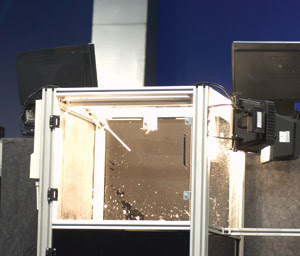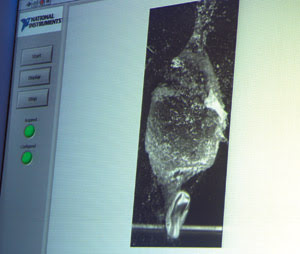The latest PC bus architecture, PCI Express, eliminates bottlenecks to enable high-speed image-acquisition, videoconferencing and other computing-intensive tasks.
Hank Hogan, Contributing Editor
First the balloon popped, and then the eyes did. All the audience had seen was the balloon, full of water, disappear, to be replaced in an instant by red rubbery fragments and a splash. The sequence of events, however, had been captured at hundreds of frames per second by a camera from Basler AG of Ahrensburg, Germany. That data had been transferred into a computer by an image-acquisition board based on the latest PC bus architecture, PCI Express.

At a demonstration of an image-acquisition board based on the latest PC bus architecture, PCI Express, a popping balloon served as an example of an ultrafast phenomenon too short to be detected by the human eye.
A replay revealed a dart traversing the balloon, the stretched rubber shattering and the water briefly holding shape before cascading down to the floor of the experimental chamber. With that, Kyle Voosen, vision product manager at National Instruments Corp. of Austin, Texas, had demonstrated the power of his company’s image board.
The ability of the board — which the company expects to begin shipping in December — to track the balloon’s demise rests on the fact that, among other things, it breaks the data-acquisition barrier of the current PC bus standard, PCI, which is approximately 100 MB/s.

A computer employing the board, connected to a high-speed camera, tracked the sequence of events, revealing the shattering of the rubber by a dart.
“We couldn’t go above that because the PCI bus is a bottleneck,” Voosen said. That data rate, he added, is much less than the fastest speed implemented several years ago by camera makers in the Camera Link standard.
Popping the balloon, he continued, showed how the situation had changed. “What we’ve done now is, we’ve gone all the way to full configuration — Camera Link, 680 MB/s. That’s a lot of data, and for that we have the PCI Express bus.”
Future direction
National Instruments’ card consists of two large field-programmable gate arrays and a chip that communicates over the new bus. Besides acquiring images very rapidly, the product points to a future direction for computer technology. It also indicates coming changes in image acquisition, video and any other add-in PC cards.
This transformation isn’t dependent solely on the greater data rates that are possible using the new standard. Extensions to PCI also broke 100 MB/s, but Voosen noted that the industry did not widely accept them. Therefore, they didn’t benefit from the cost reductions and performance improvements that would have been obtained by production in mass-market volumes.
The PCI Express bus, on the contrary, will be a standard and won’t be confined to niche status. “Every new chip set product that we’ll be announcing will be driving PCI Express first and foremost,” said Jim Pappas, director of technology initiatives in the enterprise platform group at Intel Corp. of Santa Clara, Calif.
Pappas said that the current Intel chip sets, which form the processing heart of both desktop and server computers, have supported PCI Express since September. Chip sets intended for laptop and other mobile applications, he said, soon will do the same. Intel’s microprocessor rival, Advanced Micro Devices Inc. of Sunnyvale, Calif., also has had chip sets that support PCI Express since early this fall.
By then, two leading PC makers, Dell Inc. of Austin, Texas, and Hewlett-Packard Co. of Palo Alto, Calif., already had machines on the market sporting the new bus. According to PCI-SIG of Portland, Ore., the industry group in charge of the standard, more than 22 add-in cards and eight systems passed compliance tests for the standard during late summer.
New standard in near-term
Given this momentum, the expectation among industry watchers is that PCI Express will become the standard, sweeping aside its more-than-a-decade-old predecessor. The conversion, however, won’t happen overnight.
“I would say it would take two years for it to roll in,” said Roger L. Kay, vice president of client computing at the Framingham, Mass.-based information technology analysis firm IDC. “But in the 2008 time frame, you’d see it as mainstream.”
The consensus is that computers will have a mixture of PCI and PCI Express slots for now. The two standards are not compatible at the hardware level, and for that reason, computer makers will have to predict how many of each type of slot they should provide.
However, in this game of guess-the-customer’s-needs, there’s another wrinkle to consider. PCI Express can come in different configurations, so computer makers will have to decide how many of each configuration to provide. These vary according to bandwidth needs. Most peripherals will be in the x1 configuration, which means they’ll use a 2.5-Gb/s, two-way channel. Graphics cards, on the other hand, will be x16, which ups the data rate sixteenfold. Such speeds are desirable for such applications as 3-D rendering — as well as for dazzling computer game graphics.
A word of caution
The different configurations have different physical connectors, with x1 being the smallest and x16 the largest. The National Instruments board sits between these two extremes, in an x4 configuration. For those interested in taking advantage of PCI Express for image acquisition, this plethora of possibilities creates the need to be cautious. Full Camera Link data rates require an x4 configuration. Clearly, the computer has to have the appropriate slots, and not all of them do.
“The only Dell systems available today with PCI Express x4 connectors are the Dell Precision 470 and 670 workstations,” said Dell spokesman Jeremy Bolen.
Such machines are intended for digital content creation, 3-D rendering and other similarly computing-intensive tasks. For its consumer and standard business desktops, Dell is adopting x1 slots for most peripherals and x16 for graphics cards. The company, according to Bolen, can incorporate x4 connectors when cards exploiting the bandwidth become available and when customers demand such a change. Thus, potential users of PCI Express for image acquisition will have to take care when buying computers.
Of course, taking advantage of any of this for image acquisition requires new hardware. Such a purchase would include not only the add-in card, but also a new computer, which may seem off-putting. Besides the greater speeds, however, there are other benefits to PCI Express.
First, PCI Express is a serial bus architecture, so rather than having to share bandwidth, peripherals and cards have exclusive access to data pipes. Second, the standard enables the user to swap boards while the machines are running. Third, it allows for applications to make a quality-of-service request. In this way, applications can have access to guaranteed bandwidth, which could be important for such uses as videoconferencing. Finally, the new bus is expected to reduce overall costs for board and PC makers. The old standard has none of these attributes.
Plans are under way to boost the speed of the bus even further. Such a change is a number of years out, but the PCI Express specification is expected to evolve over time.
For image acquisition, what PCI Express means is that the bottleneck that had previously existed in the bus is migrating elsewhere. For example, if a camera is capturing 1000 frames per second, that means that a new image appears every millisecond. Because little image analysis can be done during that time on today’s machines, faster microprocessors are likely to be needed, a fact that probably hasn’t escaped Intel’s notice.
A wireless future
I Express eliminating one bottleneck, and another falling within the next five years with the deployment of new wireless interfaces. At that point, users will be able to transmit data and images without intervening hardware.
“Rather than having to plug a cable in, you basically set the camera down next to the PC and — boom — you’ve got a high-speed link,” McGregor said.